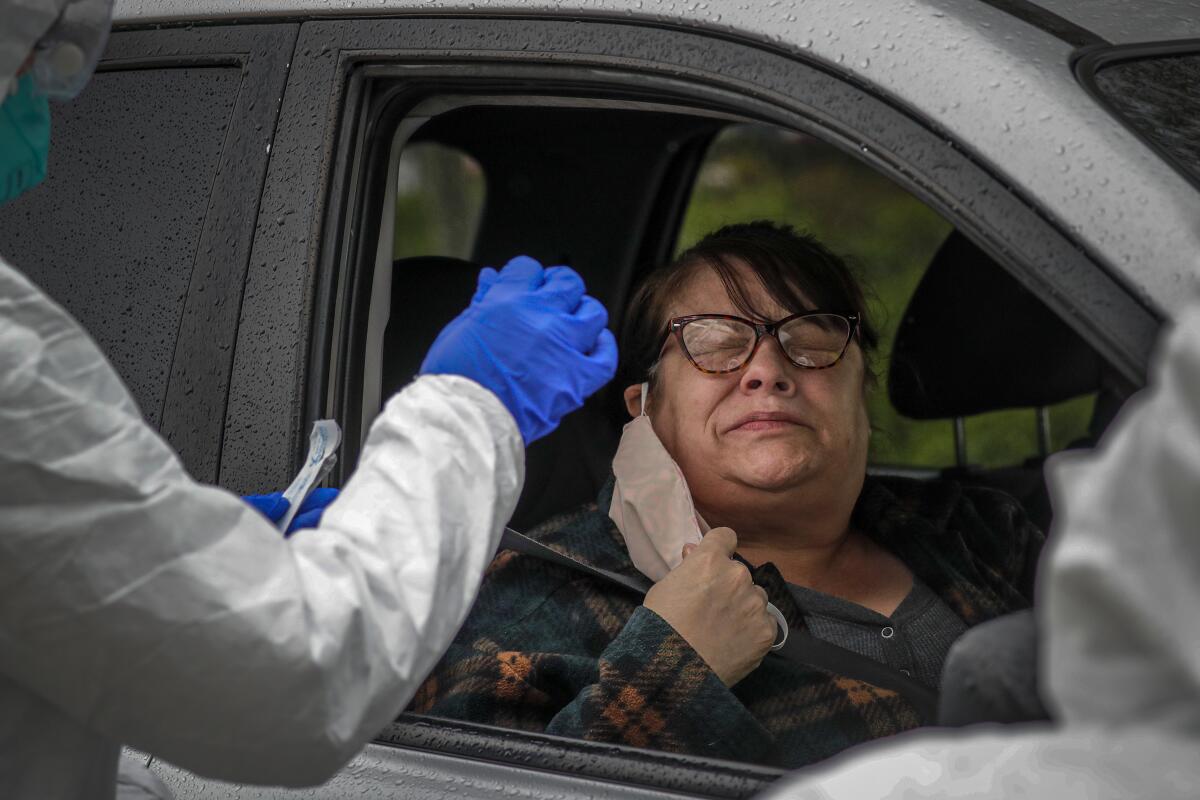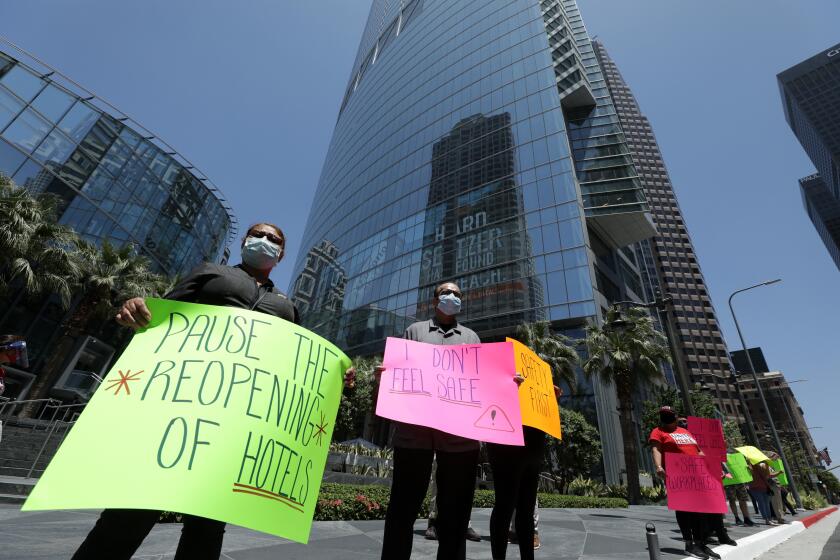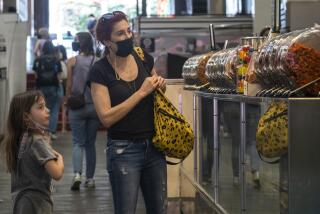With coronavirus surging, California workplaces come under greater scrutiny

- Share via
With coronavirus cases, hospitalizations and deaths hitting new records this week in California, officials are pushing for greater enforcement of workplace safety rules as a key step in slowing the spread.
Cases exploded beginning in June as the state rapidly reopened the economy and people went back to summer routines such as parties and other social gatherings. Community spread is occurring in many areas, but officials have been particularly concerned about workers getting sick at their jobs and then infecting others at home.
Latinos in L.A. County are now more than twice as likely as white residents to contract the novel coronavirus, and officials believe many of them get sick while doing essential work.
The county has seen outbreaks at food processing plants as well as manufacturing facilities such as garment factories. Los Angeles Apparel has had the worst coronavirus outbreak of any business in the county, with more than 300 of the factory’s roughly 1,800 employees testing positive. Four have died.
Health officials continue to emphasize that personal decisions are just as important as policies. Residents and business owners need to continue taking the steps necessary — including physical distancing, wearing face coverings and practicing good hand hygiene — to protect themselves, their customers and those around them.
“We’ll get to the other side of this soon enough, but it will, again, take all of us and all of our businesses to do it,” L.A. County Health Officer Dr. Muntu Davis said Thursday.
County officials unveiled a tiered enforcement plan to potentially cite and fine businesses that violate coronavirus health orders.
Starting at the end of August, noncompliant businesses will face fines ranging from $100 for a first offense to $500 and a 30-day permit suspension for multiple offenses.
Last weekend, county inspectors visited 507 restaurants, 69 hotels and 174 residential pools and found that the vast majority were complying with relevant rules, Davis said.
“We want to be reasonable and work with businesses, but we also know that time is of the essence to slow the spread of this virus and protect our residents’ health,” he said.
San Diego County announced this week a Safe Reopening Compliance Team designed to get code enforcement departments working together to pursue public complaints of health order violations and, more generally, to educate businesses.
“This is going to be the carrot approach, not the stick approach, but we still have the stick and other tools available to us, and we will use them if necessary,” San Diego County Supervisor Greg Cox said.
Many, especially those backed by labor unions, push back against returning to their workplaces, citing employers’ failures to prevent COVID-19 outbreaks.
Fellow Supervisor Nathan Fletcher zeroed in on a particular type of target for the team.
“For those egregious violators, we recognize the need to step up and have a dedicated staffing of code-compliance-type individuals focused on public health orders that can go out to egregious violations and investigate those and ensure compliance with what we’re doing,” he said.
But Dr. Wilma Wooten, San Diego County’s public health officer, said the egregious violations are not necessarily the new part of the plan for this compliance team. The most severe violations, such as a church that remained open last week after orders to hold only outdoor services took effect, have already been getting attention.
“We’ve been dealing with the egregious cases,” Wooten said. “The more moderate cases, this will allow us to be more aggressive by working with the local jurisdictions throughout the county.”
Los Angeles County continues to bear the brunt of the statewide coronavirus surge, with more than 166,000 total cases and 4,262 deaths confirmed after county health officials announced 2,014 new cases and 49 additional deaths Thursday.
So severe is the outbreak that health officials said COVID-19 is on track to be the second-leading cause of death in the county.
From January to June, COVID-19 killed about 3,400 people, according to the county Department of Public Health. Over the same period last year, only coronary heart disease was attributed as the cause of more deaths, with nearly 5,800.
During the first six months of this year, COVID-19 also killed more than twice as many people in L.A. County as pneumonia and influenza did during the last flu season, which ran from October to May, health officials said.
“One of the reasons that we’re working so hard to flatten the curve and slow the spread of COVID-19 is to limit the strain on our healthcare system so that, when flu season arrives in a few short months, we’ll be able to contain and slow the spread of COVID-19 while we know that our hospitals will also need to care for people with influenza,” Ferrer said Wednesday.
Los Angeles is far from the only county that’s seeing high levels of coronavirus activity.
Kern County reported 1,135 new COVID-19 cases Thursday — its second consecutive day in quadruple digits following Wednesday’s tally of 1,120The Times’ tracker. The last two days alone account for roughly 18% of the county’s total confirmed cases.
Throughout the pandemic, officials have preached the importance of flattening the curve — holding the rate of new infections in check — so that the healthcare system isn’t overwhelmed.
But experts say hospitalization and death totals reflect exposure to the virus that occurred weeks ago, so it takes time to see how behavioral changes are affecting transmission and whether measures implemented to stem the spread of the virus are working.
California Health and Human Services Secretary Dr. Mark Ghaly said it could take three to five weeks to see the full effects of measures the state has taken recently — including last week’s renewal of business restrictions.
Some, though, contend that the situation calls for swifter, more far-reaching action. Among those is state Sen. Steve Glazer (D-Orinda), who has called for Newsom to reimpose stay-at-home policies in most of the state until the outbreak is under control.
Specifically, the Bay Area lawmaker has proposed that counties with a 14-day positive test rate above 2% return to orders requiring residents to stay home except for essential work or trips.
The statewide positivity rate over the last 14 days is 7.6%.
L.A. Mayor Eric Garcetti — who also has raised the possibility of reimposingspecter of potentially reimposing some type of stay-at-home order if conditions continue to deteriorate — said Wednesday that although the COVID-19 threat level remains at orange, or high risk, the city is “not moving to red and we are not closing any additional businesses or activities.”
He added that the positivity rate had declined slightly for the first time in several weeks, from a seven-day average of 13.6% last week to 10% this week.
Sisson writes for the San Diego Union-Tribune.
More to Read
Sign up for Essential California
The most important California stories and recommendations in your inbox every morning.
You may occasionally receive promotional content from the Los Angeles Times.















